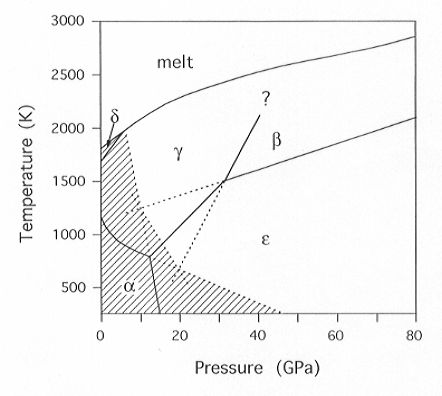

Knowledge of the phase diagram of Fe is essential for our understanding of physical and chemical properties of the Earth's core. Despite much progress in recent years, the phase diagram is still controversial, mostly due to the exceedingly difficult experimentation under the relevant extreme conditions, and the possibility that metastable phases are formed either at high P,T conditions or during quench.
Based on the topological concepts for the interconnectivity of invariant
points, stability levels as well as stable and metastable univariant reaction
curves, a model has been developed that allows regions of potential metastable
growth of high-pressure polymorphs to be constrained. An example of its
application to experimental data (of Saxena et al., Geophys. Res. Letters
1996) is given in Fig. 3.2-8. The topological analysis constrains the field
of potential
 |
Fig. 3.2-8: Phase diagram for Fe (solid lines) as proposed by Saxena et al. (Geophys. Res. Letters 1996). Metastable extensions and reactions are indicated by the stippled lines. The hatched area defines the P,T range in which a high-pressure phase could invert metastably to the b-phase. |
metastable growth of the b-polymorph from an unknown high-pressure phase to the hatched P,T region. This constraint excludes growth of a metastable b-phase by a temperature quench in the pressure region above ca. 40 GPa.

Tel: +49-(0) 921 55 3700 / 3766, Fax: +49-(0) 921 55 3769, E-mail: bayerisches.geoinstitut(at)uni-bayreuth.de
 Previous page
Previous page